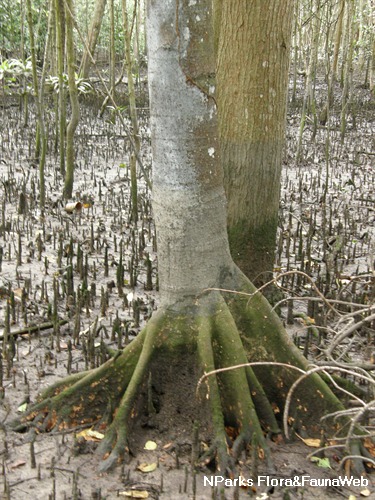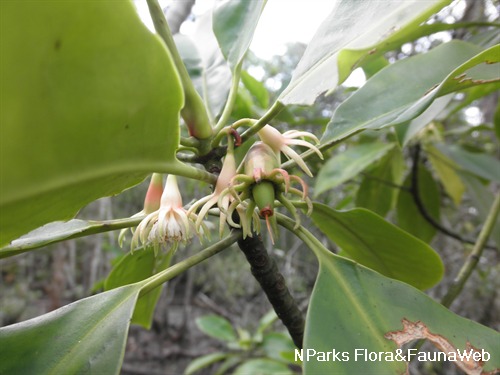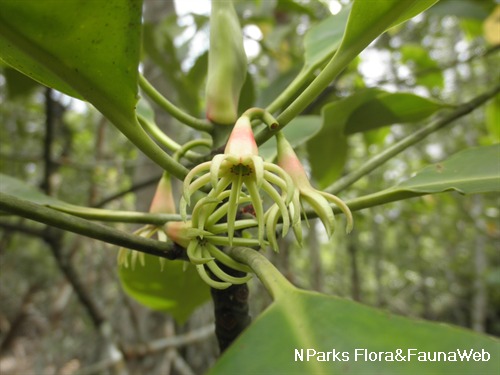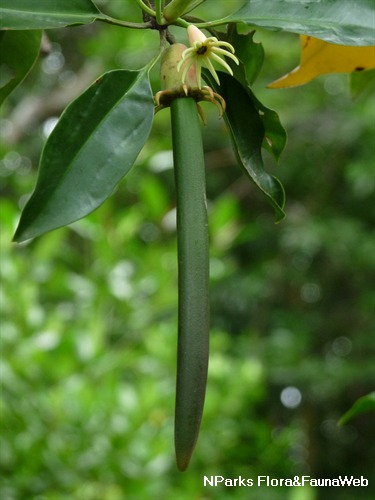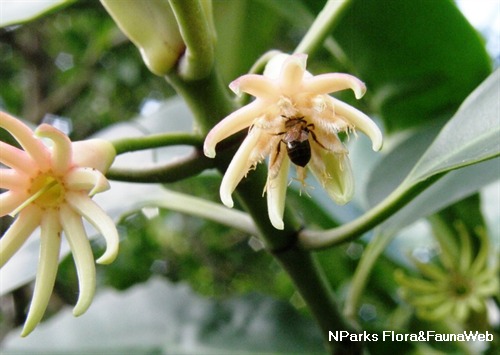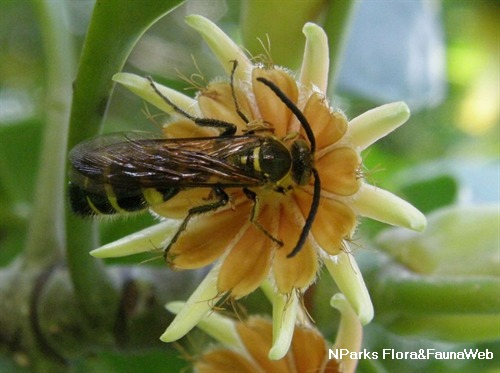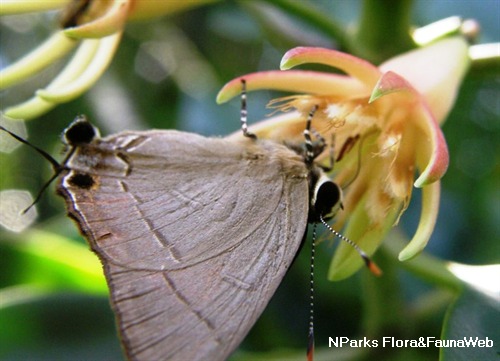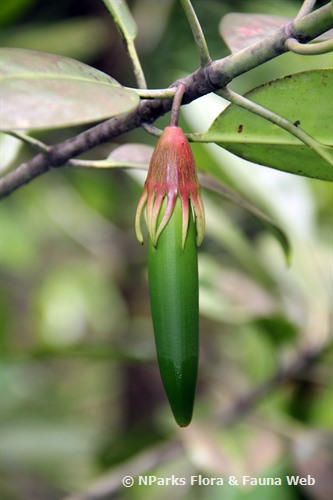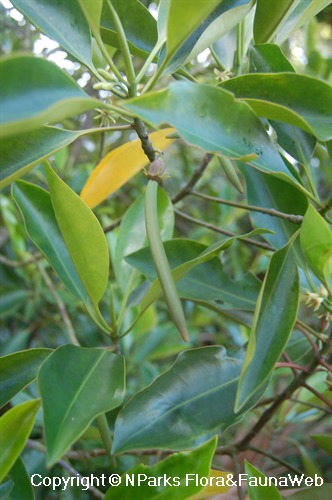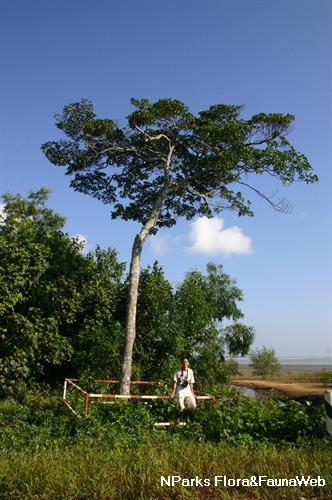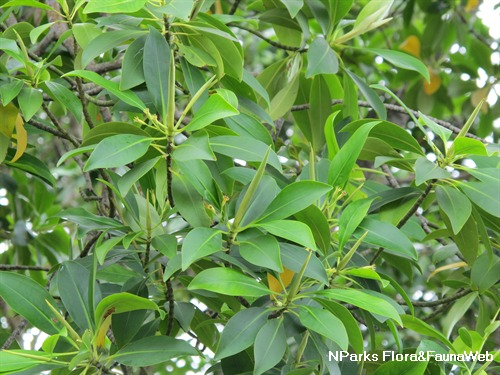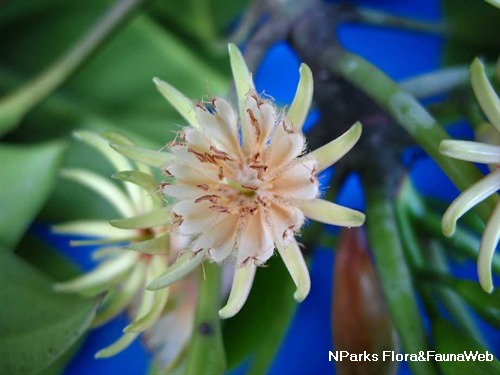
Back
Bruguiera × hainesii C.G.Rogers
| Family Name: | Rhizophoraceae |
| Synonyms: | Bruguiera hainesii C.G.Rogers |
| Common Name: | Berus Mata Buaya, Eye of the Crocodile |
Name
Classifications and Characteristics
| Plant Division | Angiosperms (Flowering Seed Plants) (Dicotyledon) |
|---|---|
| Plant Growth Form | Tree (Big (>30m)) |
| Lifespan (in Singapore) | Perennial |
| Mode of Nutrition | Autotrophic |
| Plant Shape | Columnar |
| Maximum Height | 33 m |
Biogeography
| Native Distribution | Malaya, Myanmar, Papua New Guinea, Queensland, Solomon Island, Thailand |
|---|---|
| Native Habitat | Shoreline (Mangrove Forest, Backshore) |
| Preferred Climate Zone | Tropical |
| Local Conservation Status | Native hybrid |
Description and Ethnobotany
| Growth Form | It is a medium to large-sized tree up to 33 m tall, with kneed roots that rise above the substrate. |
|---|---|
| Trunk | The tree has brown to grey bark covered with yellowish brown lenticels from bottom to top. |
| Roots | Short buttresses and kneed roots. |
| Foliage | Its opposite, long-stalked leaves have thinly-fleshy, leathery leaf blades that are oval to oval-oblong, 9–16 by 4–7 cm, shiny green on the upperside and light green on the underside. Leaf margins are smooth. |
| Flowers | The pendulous flowers are borne on short stalks, in small clusters of about 2–3 at the axillary. Calyx of each flower is pale yellowish green, 18–22 by 5 mm, top-shaped, opening up into 10 pointed lobes at the distal end. Petals are 7–9 mm long, white, forked, hairy, with 2–4 bristles at the tip. |
| Fruit | The fruit develops within the calyx, and becomes enlarged when ripened. The single seed germinates within the calyx while attached to the parent plant, forming a green hypocotyl that emerges from the calyx, known as a propagule. The propagule is cigar-shaped, slightly curved and thickened at the end, 9–22 by 1–1.2 cm, maturing from green to dark purple. |
| Habitat | It grows on landward margins of mangrove forests that are relatively dry and flooded for only a few hours a day. |
| Associated Fauna | It has been reported that the flowers are pollinated by day-flying insects, such as butterflies. The loose pollen of the flowers are held under tension by the petals of the flower. These dehisce to scatter a cloud of pollen over the head of the visiting insect when it probes at the base of the flower. The Brown-throated and Copper-throated Sunbirds (Anthreptes malaccensis) have been reported to feed at the flowers of Bruguiera × hainesii. |
| Cultivation | It is propagated by propagules produced on the tree, which can be collected when mature and planted straight into potting media. |
| Etymology | The genus Bruguiera is named after the French explorer J. G. Bruguieres (1750–1799). |
| Ethnobotanical Uses | Timber & Products: It is used as firewood and charcoal. The timber is used for construction. |
Landscaping Features
| Landscaping | This tree can be planted along the water edges of ponds and waterways, or on waterlogged soil for its attractive lush foliage. It is rather slow-growing, hence minimum maintenance is needed. |
|---|---|
| Desirable Plant Features | Ornamental Foliage, Ornamental Form |
| Landscape Uses | Coastal, Beachfront / Shoreline, Riverine, Pond / Lake / River, Marsh / Bog |
| Thematic Landscaping | Water Garden, Marsh Garden |
Fauna, Pollination and Dispersal
| Fauna Pollination Dispersal Associated Fauna | Bird-Attracting (Flowers) |
|---|---|
| Pollination Method(s) | Biotic (Fauna) (Insects (Butterfly, Moth), Vertebrates (Bird)) |
| Seed or Spore Dispersal | Abiotic |
Plant Care and Propagation
| Light Preference | Full Sun, Semi-Shade |
|---|---|
| Water Preference | Lots of Water |
| Plant Growth Rate | Moderate |
| Rootzone Tolerance | Waterlogged Soils (Does not Drain Site), Fertile Loamy Soils |
| Propagation Method | Viviparious Propagule |
Foliar
| Foliage Retention | Evergreen |
|---|---|
| Mature Foliage Colour(s) | Green |
| Mature Foliage Texture(s) | Glossy / Shiny, Leathery |
| Foliar Type | Simple / Unifoliate |
| Foliar Arrangement Along Stem | Opposite |
| Foliar Attachment to Stem | Petiolate |
| Foliar Shape(s) | Non-Palm Foliage (Oval, Oblong) |
| Foliar Venation | Pinnate / Net |
| Foliar Margin | Entire |
| Foliar Apex - Tip | Acute |
| Foliar Base | Cuneate |
Non - Foliar and Storage
| Trunk Type (Non Palm) | Woody |
|---|---|
| Mature Bark Texture | Lenticellate |
| Root Type | Underground, Aboveground |
Floral (Angiosperm)
| Flower & Plant Sexuality | Bisexual Flowers |
| Flower Colour(s) | Cream / Off-White, Green, White |
|---|---|
| Flower Location | Axillary |
| Flower Symmetry | Radial |
References
| References | Noske, R.A. 1993. Bruguiera hainesii: another bird-pollinated mangrove?. Biotropica. 25(4). 481-483 Sheue, C.R., J.W.H. Yong and Y.P. Yang. 2005. The Bruguiera (Rhizophoraceae) species in the mangroves of Singapore, especially on the new record and the rediscovery. Taiwania. 50(4). 250-260 |
|---|
Image Repository
Others
| Master ID | 29693 |
|---|---|
| Species ID | 4002 |
| Flora Disclaimer | The information in this website has been compiled from reliable sources, such as reference works on medicinal plants. It is not a substitute for medical advice or treatment and NParks does not purport to provide any medical advice. Readers should always consult his/her physician before using or consuming a plant for medicinal purposes. |

